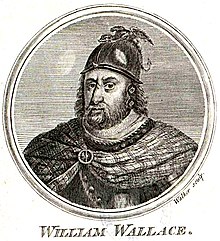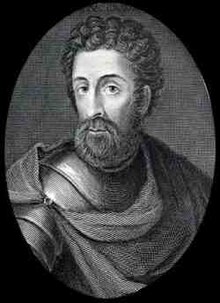William Wallace
Sir William Wallace of Elderslie, in medieval Gaelic : Uilliam Uallas ; modern Gaelic: Uilleam Uallas ; Latin : Guillelmus Walois de Scotia miles ; French : William Walleys (* around 1270 in Elderslie near Paisley in Scotland , † 23 August 1305 in London ), was a Scottish freedom fighter .
person
Wallace's date of birth and his place of birth are not clearly established. Wallace is believed to have been born between 1270 and 1280. In a 16th century history work, History of William Wallace and Scottish Affairs , the year of birth is given as 1276. There are also various statements about the place of birth, traditionally Elderslie near Johnstone in Renfrewshire , alternatively its origin is claimed from Ellerslie in Ayrshire . Against Ellerslie it is argued that it is only mentioned in the 19th century (as a mining settlement), while Elderslie was mentioned much earlier. What is certain is that his first battle took place within 30 miles of both settlements.
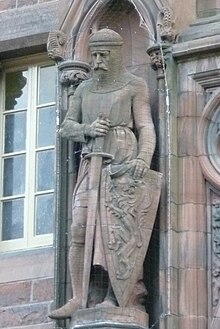
The historian Norman Davies considers it possible that he comes from a Cumbrian family of the former Kingdom of Strathclyde , since his last name Wallace ( Uallas ) means "Welsh". The determination of the name of his father is also not clear, he is handed down as Malcolm Wallace, but the knight David Wallace from the entourage of James Steward , who came from Riccarton near Galston in Ayrshire, recently confirmed by a seal find, is also available . With the derivation from the latter, the version of the origin from Ellerslie is also supported.
There is no further evidence for his person. Blind Harry invented a youth story for his epic work The Wallace in the late 15th century , which should explain the development of Williams to the Scottish freedom fighter. According to Harry, Wallace spent some time in his youth with his uncle Argheim, a cleric , at Cambuskenneth Abbey, near Stirling , where he learned to read and write.
Wallace's height is speculated in contemporary sources. According to Bower , he was six feet tall .
Historical meaning
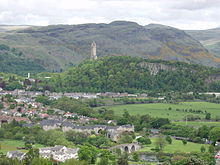
William Wallace was one of the leaders of the resistance against Edward I of England ( Edward Longshanks ), who claimed supremacy over Scotland and had forced the Scottish King John de Balliol to abdicate in 1296. Together with Andrew De Moray, Wallace inflicted a crushing defeat on the English troops under John de Warenne on September 11, 1297 at the Battle of Stirling Bridge , but Murray was seriously wounded. As a result, the two now expelled the remains of the English administration from Scotland and were proclaimed by the Scottish nobility as Guardians of the Realm to regents of Scotland in the name of King John Balliol, who was in English captivity. Wallace was also in Selkirk to beat Knight . Wallace even carried out a raid, possibly with Malise, Earl of Strathearn , through the English counties of Northumberland and Cumberland . From this time, namely October 11, 1297, comes the only surviving document that goes back to William Wallace and Andrew Murray as exhibitors and with which they promised the Hanseatic cities of Hamburg and Lübeck free traffic with all Scottish ports. It is kept in the archive of the Hanseatic City of Lübeck . On July 22nd, 1298 he was defeated by Edward I in the Battle of Falkirk . As a consequence of the defeat, Wallace resigned from his position as Guardian and stayed temporarily in France . He was succeeded as Guardians by Robert the Bruce, 4th Earl of Carrick , and John III. Comyn , nephew of John Balliol.
execution
Sir William Wallace was betrayed for a heavy reward by Sir John de Menteith, lord of Dumbarton Castle . Wallace was captured on August 5, 1305 in Robroyston near Glasgow . Shortly thereafter, he was tied to a horse and taken to London on a two-week trip. There he was charged with high treason and sentenced to death by hanging, disembowelling and quartering . This was the standard punishment for treason of the king in Britain until the early 19th century. The execution took place on August 23, 1305. According to a chronicler, he was tied to a horse and strolled naked through the streets of London for several hours while residents pelted him with stones.
Wallace was then hanged almost to death, then castrated and gutted while still alive - the removed body parts and innards were burned in front of the convict and onlookers. According to legend, he is said to have shouted to his tormentors under torture that he was Scotch and did not recognize Longshanks as his king before he finally succumbed to his torments. Also passed down as a legend are the words: “You English dogs, you are effeminate whores, you kiss my Scottish bum and you are proud to be able to do this, nothing better can happen to a miserable Englishman!” Wallace's body was dismembered: his Arms and legs were sent to Newcastle , Berwick-upon-Tweed , Stirling and Perth as a deterrent . His head was impaled on London Bridge .
A plaque at St Bartholomew's Hospital in Smithfield commemorates the place of his execution.
Appreciations
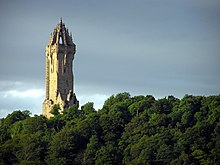
The Wallace Monument is a 67 meter high tower that was erected near Stirling in 1869 to commemorate the Scottish national hero. The monument is now a major tourist attraction. There you can also see the sword that William Wallace is said to have wielded. According to legend, he is said to have killed 50 mounted soldiers in a row with this sword.
Patriotic Scots, on the other hand, worship folk heroes and martyrs in more contemplative places, such as the Caledonian Temple of Fame above Dryburgh / Scottish Borders .
reception
- Blind Harry's 1477 poem The Wallace depicts his life with some freedom and was very popular.
- The Life of William Wallace was the template for the 1995 US feature film Braveheart, starring Mel Gibson in the title role. However, for dramaturgical reasons, this film contains a number of historical inaccuracies.
- William Wallace is part of a game mechanics learning campaign in Age of Empires II .
- In the game Medieval 2: Total War William Wallace appears in the so-called Britannia campaign ; in this he leads as a Scottish freedom fighter well-armed peasant troops.
- William Wallace is one of the main characters in the PC game Highland Warriors ; a campaign of eight missions is dedicated to him.
- The song The Clansman from the album Virtual XI (1998) by the British heavy metal band Iron Maiden is written "from the point of view" by William Wallace.
- The German heavy metal band Grave Digger dedicated the song William Wallace (Braveheart) to Wallace on their concept album about Scottish history, Tunes of War .
literature
- Blind Harry : The Wallace (also known as Blind Harry's Wallace ). This book is still considered the Scottish national epic and is one of the most widely read literary works in Scotland. It is the only literary source on William Wallace and was written nearly 150 years after his death.
- Pete Armstrong: Stirling Bridge & Falkirk 1297-98. William Wallace's rebellion (= Osprey Military Campaign Series 117). Osprey Publishing, Oxford 2003, ISBN 1-84176-510-4 .
- GWS Barrow : Wallace, William. In: Lexicon of the Middle Ages . Volume 8: City (Byzantine Empire) to Werl. Study edition. Metzler, Stuttgart 1999, ISBN 3-476-01742-7 , Sp. 1979-1980.
- DJ Gray: William Wallace. The King's Enemy. 1st edition, reprinted. Robert Hale, London 1996, ISBN 0-7090-4329-5 .
- James Mackay: William Wallace. Brave Heart. Reprinted edition. Mainstream Publishing, Edinburgh a. a. 1996, ISBN 1-85158-823-X .
- John Watney: William Wallace. Braveheart. Jarrold Publishing, Norwich 1997, ISBN 0-85372-848-8 .
- EG Spitzer: Wallace - Freedom alone. Ellerslie, Stuttgart 2012, ISBN 978-1-4775-4989-6 .
Web links
- Literature by and about William Wallace in the catalog of the German National Library
- Wallace Monument (English)
- Undiscovered Scotland: Wallace Monument (English)
- Undiscovered Scotland: William Wallace . Short biography
Individual evidence
- ↑ Norman Davies: Vanishing Empires. The history of forgotten Europe. Theiss, Darmstadt 2013, p. 95 f.
- ^ AAM Duncan: William, Son of Alan Wallace: The Documents . In: Edward J. Cowan (Ed.): The Wallace Book . John Donald, Edinburgh 2007, p. 42-63 .
- ↑ William Wallace, Scottish Hero
- ^ Sarah Crome: Scotland's First War of Independence. Sarah Crome, 1999, ISBN 978-0-9536316-0-5 , p. 57.
- ↑ Anglicana 12a, Edition: Lübeckisches Urkundenbuch , Volume 1, Lübeck 1843 (digitized version ) , No. DCLXVIII, pp. 599f., Illustration , see also Lübecker Nachrichten of September 21, 2010, ZDB -ID 526232-x
- ↑ William Wallace ( Memento from February 12, 2013 in the web archive archive.today ) In: The Biography Channel
- ↑ schottlandportal.de ( Memento from February 18, 2007 in the Internet Archive )
| predecessor | Office | successor |
|---|---|---|
| no direct predecessors |
Guardian of Scotland 1297–1298 Co-regent: Andrew de Moray (1297) |
Robert the Bruce , John III. Comyn |
| personal data | |
|---|---|
| SURNAME | Wallace, William |
| ALTERNATIVE NAMES | Walleys, William |
| BRIEF DESCRIPTION | Scottish freedom fighter |
| DATE OF BIRTH | 1270 |
| PLACE OF BIRTH | Paisley , Scotland |
| DATE OF DEATH | August 23, 1305 |
| Place of death | London |
